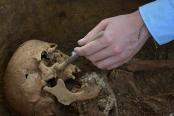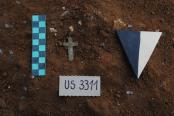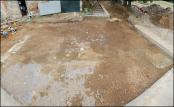CAMPAGNA 2014 |
1° SETTIMANA |
2° SETTIMANA |
3° SETTIMANA |
4° SETTIMANA |
5° SETTIMANA |
6° SETTIMANA |
7° SETTIMANA |
8° SETTIMANA |
26 GIUGNO 2014 
Resoconto della giornata di scavo
Area 2000
Nel Settore B prosegue la messa in luce dell'individuo Usk 2399 legato alla fase di colera. Contemporaneamente è stato esposto anche lo strato di calce (US 2400) che va a coprire solo parzialmente lo scheletro e che si concentra in particolar modo al di sotto, creando una sorta di letto. Come negli altri casi documentati lo scorso anno, anche in questo le ossa sono ottimamente preservate; l'individuo è orientato Sud Nord, presenta gli arti superiori flessi sull'addome, quelli inferiori distesi paralleli e il cranio risulta in parte ruotato all'indietro e dislocato rispetto alla posizione originaria per la probabile presenza di un cuscino che non si è ad oggi conservato. Interessanti sono gli elementi di corredo rinvenuti associati allo scheletro: si tratta di due bottoni in osso posti sia a livello delle ultime vertebre cervicali, sia a livello delle vertebre toraciche, ad indicare la presenza di una veste, e di un paricolare pendente in osso con forma antropomorfa femminile, posto a fianco dell'emitorace sinistro.
Ancora nel medesimo settore sono stati messi in luce altri due individui afferenti alle fasi cronologiche più antiche:
Usk 2389, orientato Ovest Est, è stato disturbato a Sud dalla fossa de colera US-2272; rimangono pertanto visibili l'arto superiore sinistro, il piede sinistro, il piede destro e solo le epifisi distali della tibia e della fibula destra. Questa sepoltura è databile a fasi antecedenti al XV secolo, in quanto le ossa in connessione proseguono al di sotto del muro che delimita il cimitero più moderno.
Usk 2401 è anch'esso orientato Ovest Est e probabilmente fa riferimento alla medesima fase cronologica; dell'individuo si conservano il cranio in norma laterale destra, il torace, i due arti superiori mentre la metà inferiore è stata intercettata dalla fossa del colera US-2220.
Nel Settore A è stato indagato e documentato il taglio US -2399 all'interno della vasca laterizia, il quale risulta vuoto; sul fondo si notano alcune ossa in connessione di un'ulteriore fossa sepolcrale più antica.
The expanded area of section 2000A was cleaned, unearthing a number of scattered bones and several potential cuts. One of these cuts was excavated along the Southwest corner of the expanded section of 2000A, revealing an extended burial oriented east/west. A potential cut oriented east/west was investigated within the brick structure along the Northwest corner of the original area of section 2000A. Further investigation revealed a set of medieval bones that was oriented on the far east of the cut, and appeared to run diagonally underneath the brick structure. The skeleton will be left in situ because it cannot be excavated. Three burials were located in section 2000B. The first, oriented north/south and next to the north side of the area, contains a male skeleton resting on a bed of lime. The left side of the pelvis is also encased in lime. The skeleton has been almost entirely exposed. One button rests on the spine and another button rests on the pelvis. There was also a pendant in the right chest area. The burial pit was slightly too short for the body and as such, the foot bones are slightly compressed. This burial will add to the collection of cholera burials and thus add to our understanding of the epidemic. The second burial is located perpendicular to the wall present on the west limit of Area B. The upper portion of the skeleton is located under the wall and therefore can only be partially excavated. The left ilium was exposed along with the left femur, tibia, fibula, tarsals, metatarsals and phalanges. The lower portion of the right tibia and tibia were present along with the tarsals, metatarsals, and phalanges. The skeleton was oriented on its side with the right side towards the bottom of the cut. The third burial is also located perpendicular to the wall on the west limit of Area B and to the north east of the second burial. This burial intersects two previously excavated burials perpendicularly. Only the upper portion containing the skull, upper ribs, humeri and the left radius and ulna have been uncovered. The right ulna and radius have been removed a few centimeters below the elbow joint because one of the other cuts intersects it here. The lower portion of the skeleton should be located where the other previously excavated cut is. These burials will increase our understanding of the medieval contexts to which they correlate.
Area 3000
Dopo una giornata di pioggia è stato possibile riprendere l'indagine del Settore B, esteso nella porzione di area compresa fra la facciata attuale della chiesa, il perimetrale nord (USM 3073), la facciata medievale (USM 3380) ed il perimetrale meridionale (USM 5003). In particolare si è proceduto con la pulizia generale dell'intero settore, che ha reso possibile la messa in luce di alcuni tagli di forma ellittica appartenenti probabilmente a fosse sepolcrali riferibili al XVIII secolo, come sembra testimoniare il ritrovamento di alcune medagliette votive, crocifissi in bronzo ed alcune monete databili al 1758. Nella porzione sud-orientale del settore è stata individuata una tomba (US - 3381) orientata S-N e collocata immediatamente a N-E del perimetrale meridionale; tale fossa sepolcrale sarà indagata nel corso della giornata di domani.
Today in area 3000, the morning began by cleaning the newly reopened section of the area (known as sector A). The team then finished cleaning and leveling sector B inside of the abbey bringing it down to the same stratigraphic layer present in sector A. In sector B, a burial pit with a distinct soil fill was visible in the east section of the area, in front of the entrance of the modern church. The pit is large enough to possibly be multiple graves or pits, and is oriented in a north to south fashion. Evidence of a cranium and several other bones was seen, and more are expected to be found with deeper excavation. Just past the end of the pit to the south, evidence of another individual was found, based on phalanges, ribs, and a vertebral column. This individual is also oriented north to south, with its head against the southern wall of the church. We intend to continue excavation of this individual and uncover more of the body starting tomorrow. On the easternmost edge of sector B, there was evidence of more pits cut through the top layer of yellow clay, with scattered bones indicating the possibility of more burials there. Near the south west corner and perpendicular to the south wall of the original abbey the lower limbs of an individual orientated north south and a cranium situated at the end of the lower limbs. Another find today was a small bronze cross medallion found near the center of sector B. The cross was about an inch and a half long with inscriptions. Also found was a small round medallion with an angel and a saint on each side. This medallion was particularly interesting because in addition to the loop on the top, it had two smaller loops on each side.
Area 5000
È terminata oggi la pulizia generale dell’area con la messa in luce di diverse evidenze stratigrafiche i cui rapporti verranno indagati nei prossimi giorni. Tale pulizia ha permesso di produrre le prime documentazioni fotografiche, aeree e di particolare, utili per una visione d’insieme di questa porzione del sito.
Today at Badia Pozzeveri we completed the initial stage of cleaning for the newly expanded area 5000. In these cleaning stages, we used pickaxes, shovels and trowels to further expose the slate layer along the eastern wall of the sight. In the process of cleaning along this wall we uncovered a cluster of slate and brick as well as continuing to find pottery shards and 18th century nails. This may prove to expand further in future excavation. In the southwest corner, we believe to have exposed the entirety of the limits of the moltar pit. We concluded the day by taking aerial photographs of the cleaned layer. Tomorrow our primary goal will be to delineate different contexts within out area and commence excavations of features.

















